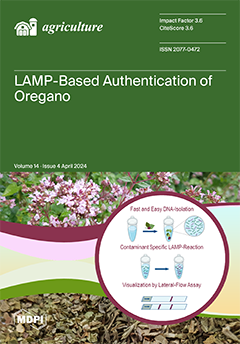The solid-state fermentation (SSF) efficiency of
Bacillus licheniformis ATCC 21424 (BL) on various agro-industrial by-products such as oilseed cakes [hemp (HSC), pumpkin (PSC), and flaxseed (FSC)] was evaluated by examining the nutritional composition, reducing sugars, and in vitro protein digestibility (IVPD) for use
[...] Read more.
The solid-state fermentation (SSF) efficiency of
Bacillus licheniformis ATCC 21424 (BL) on various agro-industrial by-products such as oilseed cakes [hemp (HSC), pumpkin (PSC), and flaxseed (FSC)] was evaluated by examining the nutritional composition, reducing sugars, and in vitro protein digestibility (IVPD) for use in animal nutrition. SSF significantly decreased crude protein, along with changes in the total carbohydrates (
p < 0.05) for all substrates fermented. An increase in crude fat for HSC (1.04%) and FSC (1.73%) was noted, vs. PSC, where the crude fat level was reduced (−3.53%). Crude fiber does not differ significantly between fermented and nonfermented oilseed cakes (
p > 0.05). After fermentation, neutral detergent fiber (NDF) and acid detergent fiber (ADF) significantly increased for HSC and FSC (
p < 0.05), as well as for PSC despite the small increase in ADF (4.46%), with a notable decrease in NDF (−10.25%). During fermentation, pH shifted toward alkalinity, and after drying, returned to its initial levels for all oilseed cakes with the exception of PSC, which maintained a slight elevation. Further, SSF with BL under optimized conditions (72 h) increases the reducing sugar content for FSC (to 1.46%) and PSC (to 0.89%), compared with HSC, where a reduction in sugar consumption was noted (from 1.09% to 0.55%). The viable cell number reached maximum in the first 24 h, followed by a slowly declining phase until the end of fermentation (72 h), accompanied by an increase in sporulation and spore production. After 72 h, a significant improvement in water protein solubility for HSC and FSC was observed (
p < 0.05). The peptide content (mg/g) for oilseed cakes fermented was improved (
p < 0.05). Through gastro-intestinal simulation, the bacterial survivability rate accounted for 90.2%, 101.5%, and 85.72% for HSC, PSC, and FSC. Additionally, IVPD showed significant improvements compared to untreated samples, reaching levels of up to 65.67%, 58.94%, and 80.16% for HSC, PSC, and FSC, respectively. This research demonstrates the advantages of oilseed cake bioprocessing by SSF as an effective approach in yielding valuable products with probiotic and nutritional properties suitable for incorporation into animal feed.
Full article





